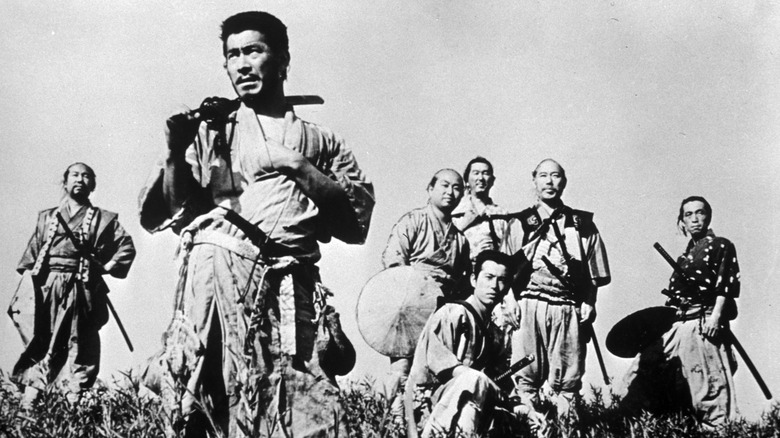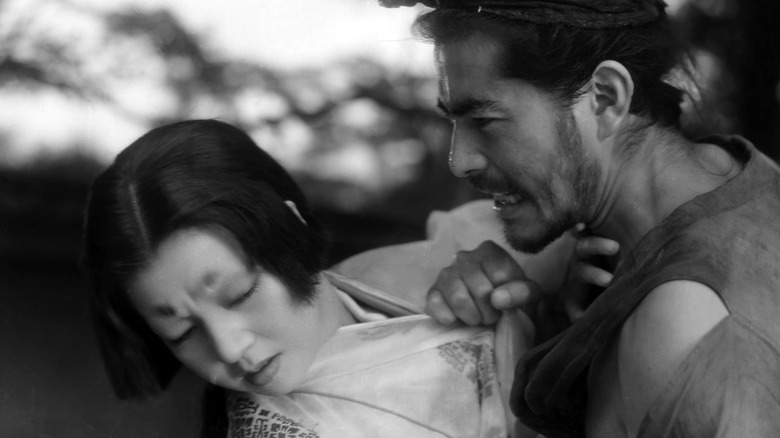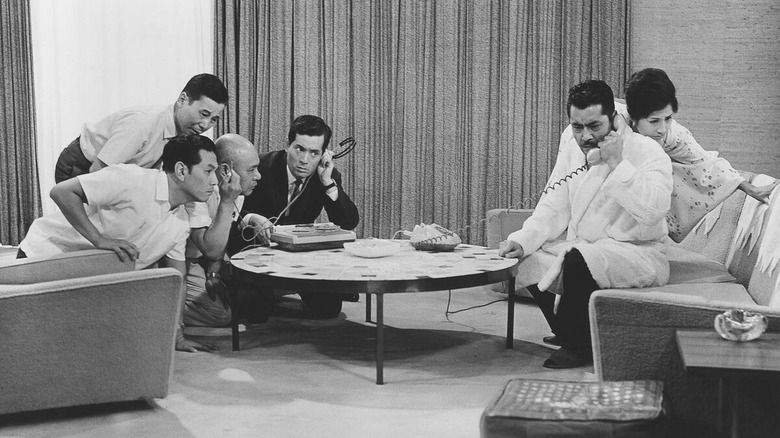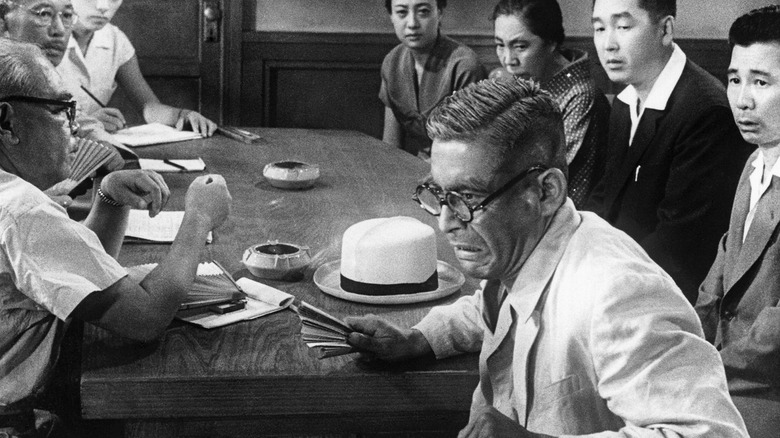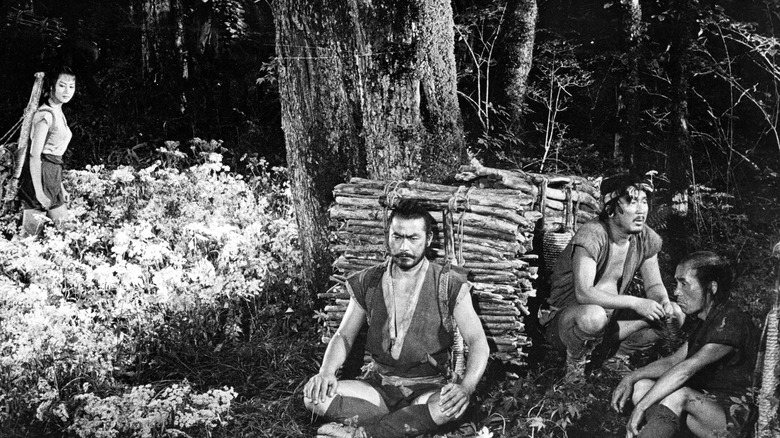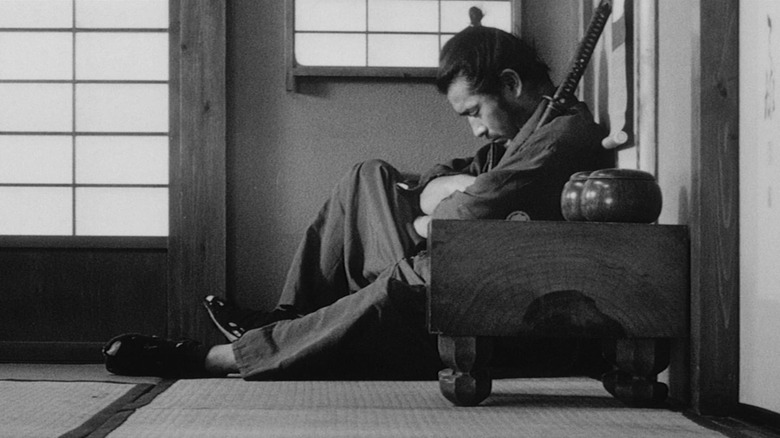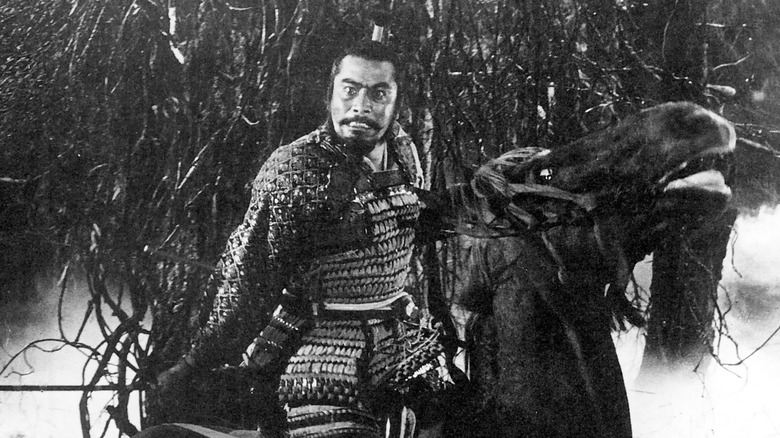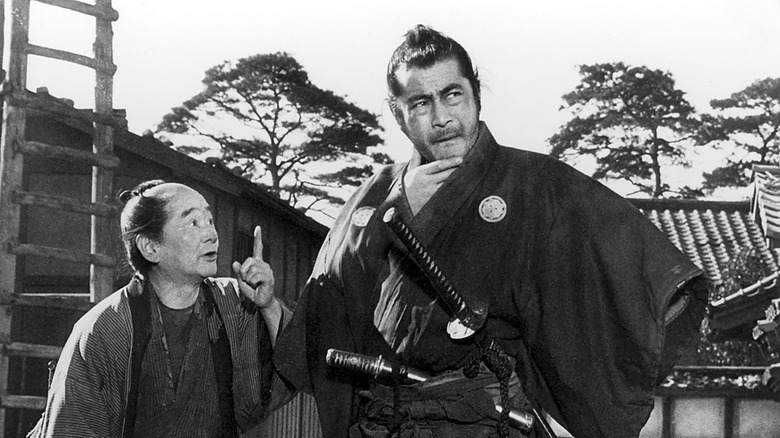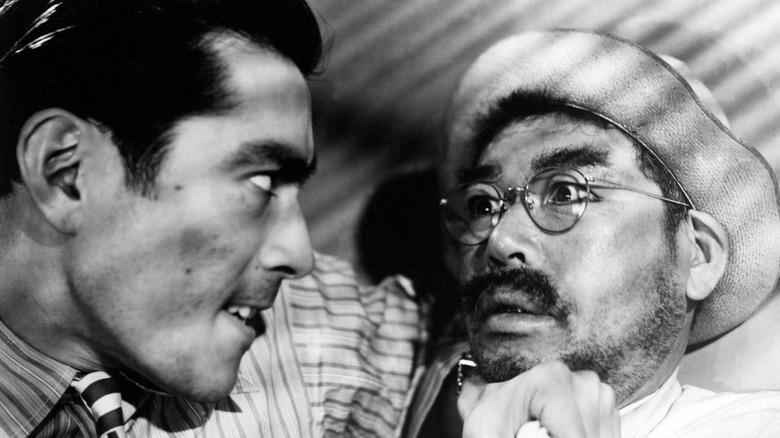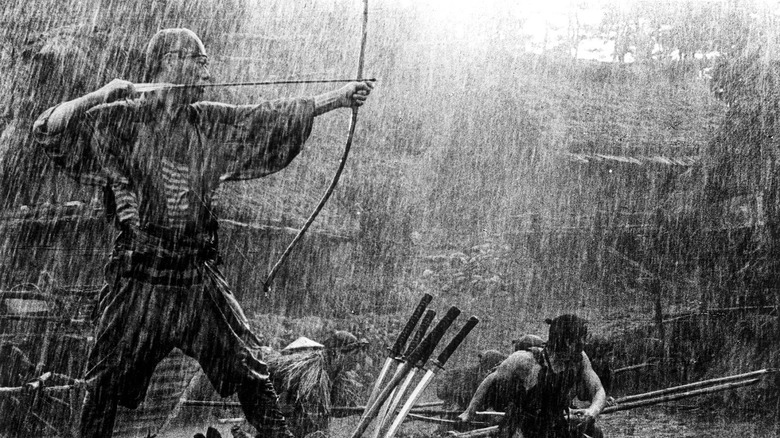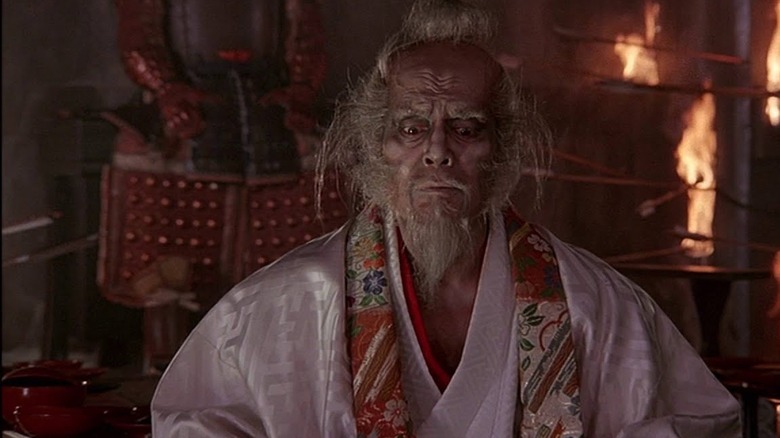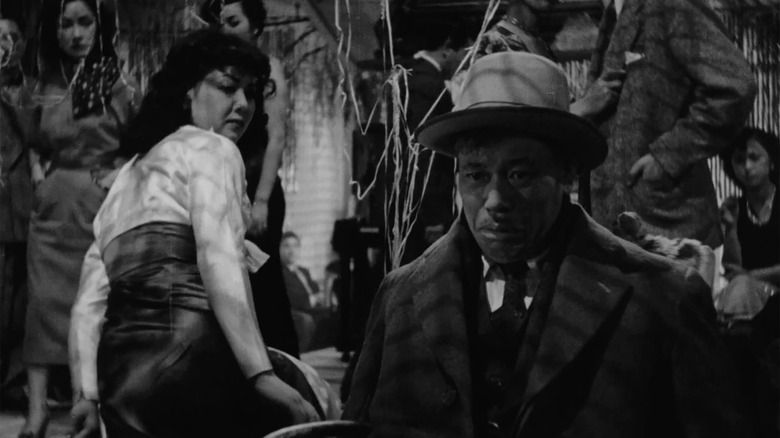The 11 Best Akira Kurosawa Movies, Ranked
It's impossible to overstate just how impactful Akira Kurosawa's body of work has been on cinema. Given how ubiquitous his influence is, it can be easy to forget the specific factors that made Kurosawa such a remarkable filmmaker. Kurosawa could do period pieces set throughout the history of Japan that still register as deeply relevant. Just as impressive was his willingness to explore a wide variety of genres from crime thrillers to intimate dramas to jidaigeki features and everything in between.
Perhaps most important of all is the quiet sense of hopefulness that courses through Kurosawa's work. His movies, especially the dramas set in modern Japanese society coping with the aftereffects of World War II, are quite aware of the brutalities of the world and the horrors man can cause. While some titles like "Ran" were wall-to-wall bleakness, many of his other projects depicted isolated samurais coming in to save the day, or doctors opting not to give up on the future even when everything looks hopeless. These are the 11 movies that made Akira Kurosawa a legend.
11. Rashomon
Kurosawa always had a gift for filming the organic world. Rolling hills, fields of grass, and vast skies always looked so expansive and stunning in his hands. "Rashomon" begins with protagonists Kikori (Takashi Shimura) and Tabi (Minoru Chiaki) sitting inside a dilapidated building while a deluge of rain comes down outside. The presence of rain is captured in a striking manner that conveys how these two characters are overwhelmed by everything around them — including the vastly different tales they've just heard about a samurai's murder and the rape of his wife.
These stories are the crux of "Rashomon" and prove why this movie has remained so influential. Any movie that opts to tell one story from multiple perspectives will forever be compared to "Rashomon." Even after so many imitators, the way "Rashomon" uses varying accounts of past events to reflect the individual personalities of the narrators is still impressive. Screenwriters Kurosawa and Shinobu Hashimoto (adapting elements from a pair of short stories by Ryunosuke Akutagawa) use this narrative structure to pursue larger ideas related to subjectivity and the dishonesty of humanity that so many of the film's imitators never attempt to explore. The cast excels in depicting constantly shifting versions of their characters, ensuring "Rashomon" lives up to its harrowing, rain-drenched opening sequence.
10. High and Low
Part of what makes "High and Low" such a compelling watch is the moral ambiguity ingrained into its characters. Exemplifying this trait is our protagonist, Kingo Gondo (Toshirô Mifune). Gondo is at the center of a hostage situation, with a gaggle of kidnappers trying to extort him for money. Rather than play Gondo as a straightforward victim, "High and Low" opts to depict him as a more complicated man. For starters, he's introduced as an executive concocting an elaborate and costly scheme to gain full control of the shoe company he works for. This plan isn't necessarily evil, but it does show Gondo as someone with a flawed agenda.
This moral complexity in our lead character is made further apparent once it's revealed that the kidnappers have not taken Gondo's son. Instead, the offspring of Gondo's chauffeur has been mistakenly snatched. Gondo has a chance to be the hero and pay the ransom to save the child, but he initially refuses. Instead, he resumes his plan to take over that shoe company. These details make "High and Low" feel like it's populated with real human beings, while the work of actors like Mifune helps to accentuate that authenticity. The tangible quality of the story is just as memorable as the visuals that include an unforgettable shot that shatters the feature's monochromatic color scheme to incorporate pink smoke.
9. I Live in Fear
The specter of nuclear anxiety loomed large over many of Akira Kurosawa's films. Rarely was this more apparent than in his 1955 film, "I Live in Fear." This film centers on Kiichi Nakajima (Toshirô Mifune), a man whose life is defined by fear of nuclear annihilation. His plans to prepare for such an event escalate from creating an elaborate bomb shelter to figuring out a way to get to Brazil, a country he believes will be the only place immune from the horrors of atomic war.
In the vein of other Kurosawa classics like "Drunken Angel," "I Live in Fear" has the filmmaker contemplating the best way to navigate an uncertain future. The characters of "I Live in Fear" embody differing approaches to tackling what's to come. Such approaches generally boil down to either ignoring potential horrors or becoming consumed by them. The latter mindset is beautifully captured in Mifune's lead performance, which hauntingly portrays Nakajima losing more and more of himself to his anxiety. Although it was released a decade after the bombings of Hiroshima and Nagasaki, "I Live in Fear" is a harrowing demonstration of how the horrors of the past can overwhelm the present.
8. The Hidden Fortress
Several of Akira Kurosawa's features are deep contemplations of the nature of existence. However, he was just as capable of creating an entertaining adventure film, which is what he delivered with his 1958 jidaigeki feature "The Hidden Fortress." That's not to say there isn't craftsmanship on display here or even that one couldn't interpret greater themes in this yarn. It's just that the goal of "The Hidden Fortress," first and foremost, is to deliver excitement and thrills. These elements come from a classic plot about a general Rokurota (Toshirô Mifune) and a princess Yuki (Misa Uehara) trying to keep their true identities secret while securing help from a pair of crafty peasants.
This storyline turns out to be a great way to create tense set pieces and offers up numerous opportunities for Kurosawa regular Mifune to shine. Mifune played a wide variety of memorable characters in Kurosawa's filmography, and his range is apparent in his portrayal of Rokurota juggling two disparate identities. However, the standouts are the two peasant protagonists, Matashichi (Kamatari Fujiwara) and Tahei (Minoru Chiaki). Their status as everymen who can never catch a break (it isn't long into the runtime before they're digging their graves, after all) makes them immensely relatable. With plenty of vivid characters and excitement, "The Hidden Fortress" stands out even when compared to thematically weightier Kurosawa titles.
7. Sanjuro
Toshirô Mifune reprises his role from "Yojimbo" to headline the appropriately titled "Sanjuro." Fortunately, the film doesn't attempt to turn "Yojimbo" into the first piece of an epic saga but aims to deliver another satisfying standalone samurai adventure. Here, Sanjuro gradually becomes swept up in helping a group of nine men fight back against a corrupt superintendent. These ramshackle warriors are far from experts in combat, but the presence of Sanjuro may give them more than a fighting chance against their enemies.
"Sanjuro" is no retread of "Yojimbo," but it does continue to emphasize the intellectual power of the Sanjuro character. Sanjuro has brains to spare and can do things like get his enemies to unwittingly signal his allies to attack, even if he's (literally) all tied up. Sanjuro's cleverness is matched by the movie he inhabits. "Sanjuro" also demonstrates sharpness in depicting the realistically ragged rapport between the samurai and the collection of plucky people he's taken under his wing. Taking on an enormous task doesn't automatically turn them all into friends, and that kind of complexity makes the story extra engaging. Bringing back Sanjuro for further adventures could've resulted in diminishing returns. However, "Sanjuro" is one of the all-time great sequels that's entertaining even if you haven't seen its predecessor.
6. Throne of Blood
"Ran" wasn't the only time Akira Kurosawa adapted a classic William Shakespeare play. Decades before, he reinterpreted "Macbeth" for 1957's "Throne of Blood." As to be expected of a filmmaker of Kurosawa's creative caliber, "Throne of Blood" is not just a hollow rehash of "Macbeth," it's a vision that stands on its own, particularly in the striking cinematography of Asakazu Nakai. You don't need to be a Shakespeare scholar to appreciate either the masterful use of wide shots or the outstanding employment of fog in its most critical sequences.
"Throne of Blood" is anchored by lead performances from Toshirô Mifune and Isuzu Yamada as the film's stand-ins for Macbeth and Lady Macbeth. Mifune is perfect in his portrayal of the deterioration of his character, Taketoki Washizu. Washizu initially comes across as normal, but his quest for power shatters his mind. By the end, Mifune makes it hard to believe this is the same man from the beginning of "Throne of Blood." This transformative performance encapsulates the film's grim exploration of how deceit and greed can transform even the noblest human beings.
5. Yojimbo
"Yojimbo" begins with a ronin named Sanjuro (Toshirô Mifune) walking into a small town. This is no ordinary town, though, as it's controlled by a pair of crime syndicates. These opposing forces are terrorizing the innocent townspeople, inspiring the crusty Sanjuro to step in and help. Rather than be a superhero who springs in to make everything right instantly, Sanjuro plays the long game. What follows is a series of intellectual exercises that pit the two organizations against each other.
While "Yojimbo" revolves around Sanjuro using his intellect for games of deception, elegant simplicity is the name of the game. Watching Sanjuro constantly one-up crooks without these gangsters realizing they're being played is immensely enjoyable, especially when such sequences incorporate delightful instances of dark humor. The whole enterprise is further enhanced by the presence of Mifune in the lead role. Mifune lends an incredible amount of believability to the samurai who's lived a life rich with experience and difficulty. We don't need to see a prologue to understand the events that have shaped Sanjuro or the experiences that have given him the knowledge to take down the crime syndicates. Mifune communicates decades of experience through his physicality. This lead performance alone makes it clear why "Yojimbo" has endured as one of Kurosawa's most celebrated films.
4. Drunken Angel
One of the many striking visual details in "Drunken Angel" is a sump located in the village that Dr. Sanada (Takashi Shimura) calls home. A result of Japan getting bombed in World War II, this hideous, filthy water is a reminder to Sanada of the grotesqueness of the world. Conscious of these horrors, Sanada descends into alcoholism, but that doesn't mean he's abandoned all hope for the future. Most notably, he's become insistent on helping save the life of Matsunaga (Toshiro Mifune), a young man who's destined to die from tuberculous if he doesn't make some drastic changes.
"Drunken Angel" sees Kurosawa in a grounded mode as he explores the lives of a pair of deeply complicated human beings and their vastly different approaches to life. Through the messy interactions between Sanada and Matsunaga, "Drunken Angel" reveals its true colors as a haunting saga about the dangers of looking for easy solutions to life's pain. We're meant to empathize with the reasons for Sanada and Matsunaga's respective fixations on drinking and grisly vengeance. However, we're also supposed to realize these aren't the best ways to cope with the complexities of life. These existential elements, coupled with "Drunken Angel's" simultaneous tug-of-war between an optimistic and pessimistic outlook, culminate in one of the most poignant endings in cinema history. It's a perfect capper to an extraordinary movie.
3. Seven Samurai
Trying to write something new about "Seven Samurai" feels like as much of a fool's errand as finding a bad performance from Takashi Shimura. You don't need me to tell you that "Seven Samurai" is a special and impactful movie. Just look at how its influence has inspired everything from "The Magnificent Seven" to "The Mandalorian." The entire landscape of global cinema has been shaped by this film about seven men who must train a village to fight back against a horde of bandits. Yet, even with its pop culture legacy, it's still worth talking about the ways "Seven Samurai" excels.
The blocking and staging of "Seven Samurai" are extraordinary. With so many characters to juggle, it could've been easy for the film's leads to be derivative of one another or get lost in the shuffle of the narrative, but in any shot in which they're all together, Kurosawa's blocking speaks volumes to the distinct personalities of the individual characters. The long runtime is a boon to getting to know each member of the ensemble cast. Those climactic deaths of key characters wouldn't work as well as they do if we weren't invested in these people. "Seven Samurai" still stands as a towering achievement in filmmaking.
2. Ran
When plays are adapted for film, a common complaint is that these adaptations never feel big enough. Some just seem like they're recorded performances of stage plays. Even the most cynical viewer would never be able to level such criticism at "Ran," Akira Kurosawa's 1985 adaptation of William Shakespeare's "King Lear." "Ran" is an epic told with expansive battle sequences, massive castles, and sprawling vistas that could never be replicated on a stage. Kurosawa took the skeleton of "King Lear" and placed it into a body that takes full advantage of everything that cinema has to offer.
It's also a feature that stands out in the director's filmography for its incredible use of color. "Ran" is the apex of Kurosawa's use of bright vivid hues. Red, yellows, and especially purples look incredibly vibrant on the screen while the bright white of Ichimonji Hidetora's (Tatsuya Nakadai) outfit becomes more and more striking as the world around him succumbs to chaos. With its scope and color palette, "Ran" is a visual feast, but it's especially impactful as a commentary on the innately destructive nature of humanity. Unforgettable lines like "Men seem to enjoy suffering more than peace" lend a haunting aura to "Ran's" avalanche of eye candy.
1. Ikiru
To be the greatest movie ever directed by Akira Kurosawa also means being one of the greatest movies ever made. Such words may seem like hollow hyperbole, but in the case of "Ikiru," it's appropriate. Released in 1952, "Ikiru" follows Mr. Watanabe (Takashi Shimura), an older man who has few meaningful connections in his life. From the beginning, "Ikiru" ensnares the viewer emotionally by depicting Watanabe's life as relatable. Obligations and responsibilities come first as all of life's little nuances get drowned out by the noise of these commitments.
Watanabe's stagnant life is thrust into chaos when he learns that he has stomach cancer and will die within a year. From there, "Ikiru" uses its relatable set-up as a springboard for a fascinating exploration of what defines a fulfilling life. Kurosawa maintains a sense of realism by refusing to shy away from the brutal aspects of existence. The cognizance of all of life's heartbreak makes the tiny victories and poignant moments in the story all the more impactful. Meanwhile, Shimura, always a welcome presence in Kurosawa's work, delivers the performance of his career as "Ikiru's" protagonist. Just one haunted stare from this man can crush your heart and convey decades of anguish. "Ikiru" is a standout in even Kurosawa's stacked filmography.
